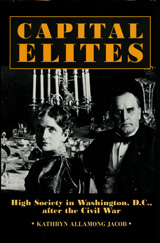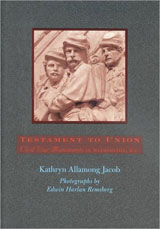by
Kathryn Allamong Jacob
Order online
| Home | About the author | Other books | Picture gallery | Contact | Order online |

Order online
Testament to Union: Civil War Monuments in Washington, D.C.
Although the monuments of Washington, D.C., honor more than two centuries of history and heroes, four years of that history produced more of the city's public commemorative sculpture than all the others combined. The heroes of the Civil War, most of them astride bronze horses, command Washington's choicest vantage points and most visible parks and lend their names to the city's most familiar circles and squares—Scott, Farragut, Logan, Sheridan, Du Pont, McPherson, and others.
In Testament to Union, Jacob tells the stories behind the city's forty-one statues that honor Civil War participants, predominantly from the Union side, and testify to their sacrifice and valor. She describes the often bitter battles over control of historical memory, the postwar monument business (a lone soldier in granite for a town square could cost a community as little as $1,000), and the rise of the City Beautiful Movement that transformed Washington. She notes who commissioned the sculpture, who paid for it (or failed to pay in several cases), and who approved its design and placement, often a contentious process, and includes anecdotes that bring the monuments more fully to life. Admiral David Farragut's statue, for example, is cast from the propeller of his beloved flagship the U.S.S. Hartford, from whose rigging he shouted, "Damn the torpedoes! Full speed ahead!"
The imagery in these monuments capture striking scenes of war and sacrifice—the straining horses and terrified men of the cavalry grouping at the magnificent Grant Monument; the eerie tomb effigy of young John Meigs, depicting him as he was found, dead in a field, shot by Confederate guerrillas; the palpable sense of urgency in the Pension Building frieze with its more than 1,355 finely detailed terra cotta soldiers and sailors marching and rowing cross the face of the building. Along with swashbuckling generals and admirals atop pedestals bristling with cannon, unexpected subjects appear: a statue of John Ericsson, the Swedish American who designed the Monitor and perfected the screw propeller for the Union navy; a bas-relief of twelve nuns honoring the various religious orders who nursed the wounded during the war.
Washington's Civil War sculptures bear witness to the struggle over the preservation of the Union. They are each the fruit of conscious efforts to shape the nation's memory of that struggle. Each is a testament to union in some sense of the word: to disunion, reunion, union, the Union. Each one is, as General David Henderson noted at the dedication of the William Tecumseh Sherman monument in 1903, a "silent historian."
Now in paperback
Order Testament to Union from Amazon
Order Testament to Union from Barnes & Noble
Order Testament to Union from the publisher -- with discount code
Capital Elites: High Society in Washington, D.C. after the Civil War

In this rich social history of the nation's capital, Jacob portrays the fancy dress balls, the scandals that reached right into the White House, and the larger-than-life personalities that characterized Washington's high society during the Gilded Age. She argues that the capital's social elite has always been unique because its fortunes—unlike those of aristocrats who ruled other American cities—are tied inextricably to the ubiquitous presence of the federal government. Boston might have its Cabots and Philadelphia its Cadwalladers, long-established families recognized as society leaders by virtue of their antiquity and wealth. Washington alone would have an official society based on specific elected and appointed offices and ironclad rules of official protocol: a deviation might not be a mere faux pas but the cause of an affair of state. Whoever held the office, no matter how low-born or venal, laid claim to that office's assigned place at table.
Capital Elites identifies three distinct, often hostile, aristocracies that competed for prominence throughout the second half of the nineteenth century. Documenting extravagant events and outrageous deeds, Jacob examines the clash between Washington's old Southern and Democratic residential elite and "official society," those elected or appointed figures—mostly Northern and Republican after the Civil War—who expected recognition regardless of pedigree, liquidity, or gentility. Jacob shows how the evolving institutions of a central government shaped every aspect of social life.
Compounding these complex and often vitriolic social interactions was the arrival of a third elite, the nouveau riche. Jacob shows how the Civil War affected Washington like no other southern or northern city, vanquishing the old hereditary elite—the starchy men and women Mark Twain lampooned in The Gilded Age as the "Antiques"—and opening the city's newly-unguarded gates to new millionaires—Twain's hilarious "Parvenues"—who shaped the postwar society of the capital as they shifted its center from the sober brick townhouses around Lafayette Square to Dupont Circle, where their ornate mansions were popping up like mushrooms after a rain.
With plentiful detail about scheming hostesses, bitter bluebloods, greedy lobbyists, senators besotted by love, and cabinet ministers who accepted bribes to support their families' social ambitions, Capital Elites describes the magnetic attraction of political power and the ways in which moneyed society affected the conduct of government during the Gilded Age.
Order Capital Elites from Amazon
Order Capital Elites from Barnes & Noble
